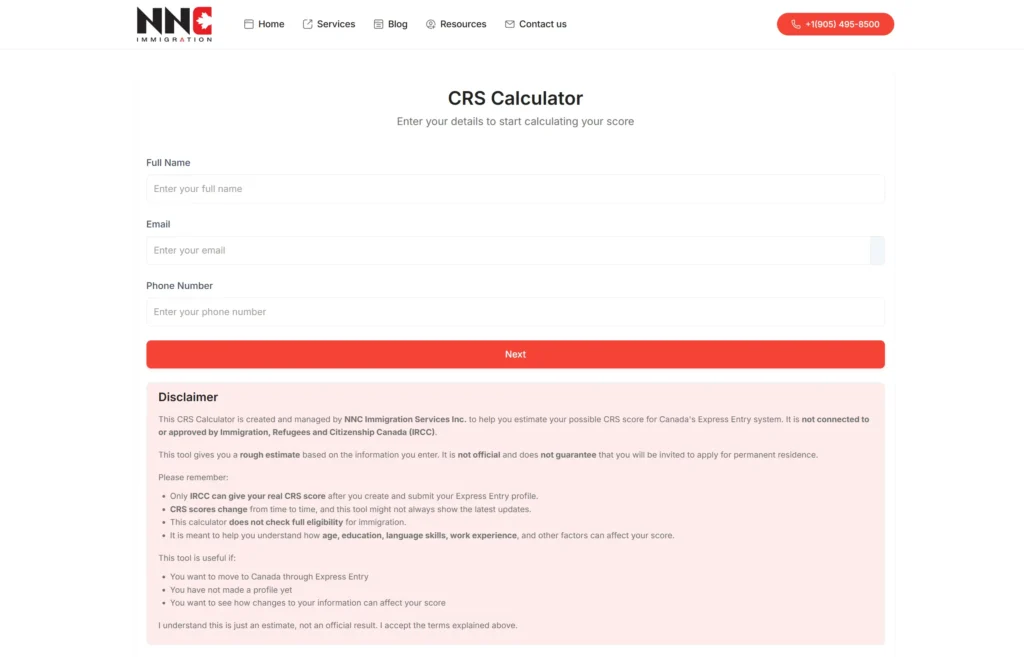Your CRS score (Comprehensive Ranking System) is a number the Canadian government uses to rank Express Entry candidates. A higher score gives you a better chance to receive an Invitation to Apply (ITA) for permanent residence. In this guide, you’ll learn what CRS is, how it’s used, and how to calculate it step by step—plus common mistakes to avoid.
Skip the math—Try NNC’s Free CRS Calculator

What is the CRS score?
The CRS score is a points system used inside the Express Entry pool. It looks at your age, education, language test results, and work experience. When the government runs an “Express Entry draw,” they invite the top-scoring candidates to apply.
Why it matters: Knowing your exact CRS lets you plan your next steps—like retaking IELTS/CELPIP, adding French, or targeting a Provincial Nominee Program (PNP).
Pro tip: There are different draw types (general and category-based). Even if your score feels average, you might still be competitive in a category-based draw (e.g., French, healthcare, STEM, trades), depending on your profile.
The CRS components (plain-English breakdown)
Core / Human Capital (you)
- Age: Younger adults usually get more points. Points drop as age increases after a certain range.
- Education: Higher education generally gives more points. If your schooling is outside Canada, you usually need an ECA (Educational Credential Assessment).
- Language (English/French): Higher CLB levels = more points. CLB 9/10 is a big boost.
- Canadian Work Experience: Even 1 year in Canada can make a strong difference.
Spouse/Partner factors (if applicable)
If you have a spouse or common-law partner, the system can split some points differently. Your spouse can also add points based on:
- Education (ECA if foreign)
- Language scores (IELTS/CELPIP or TEF/TCF)
- Canadian work experience
Spouse as principal applicant? Sometimes switching who is the principal applicant gives a higher total. Test both versions in our calculator.
Skill Transferability (combinations that multiply your points)
You can earn extra points when strong factors combine, for example:
- Education + high language scores
- Foreign work experience + high language scores
- Foreign + Canadian work experience
- These combos can push you past a draw cut-off.
Additional Points (power boosters)
- PNP (Provincial Nomination): A nomination adds a big chunk of points.
- Valid Job Offer (usually LMIA-based): Gives bonus points (amount depends on job level).
- Canadian education: A Canadian diploma/degree can add points.
- Sibling in Canada: If they are a citizen or PR and meet certain conditions.
- French: French scores can add extra points—even if English is your main language.
Calculate Yours in 60 Seconds → [Try Our CRS Calculator]
Step-by-step: calculate your CRS score manually
1) Gather your documents
- ECA for foreign education (WES, IQAS, ICES, etc.)
- Language test results:
- English: IELTS General or CELPIP General
- French: TEF Canada or TCF Canada
- NOC/TEER code for your job (make sure your duties match)
- Work history: job titles, dates, hours/week, country (Canadian vs. foreign)
2) Convert your language scores to CLB
- Use the official conversion tables to map IELTS/CELPIP/TEF/TCF to CLB levels.
- Note each skill: Listening, Reading, Writing, Speaking.
Pro tip: CLB 9+ is a major threshold for extra points in skill transferability.
3) Assign points for each factor
- Age
- Education (based on ECA or Canadian credential)
- Language (per skill)
- Canadian work experience
- Spouse factors (if any)
- Skill transferability combos
- Additional points (PNP, job offer, Canadian study, sibling, French)
4) Add them up and double-check
- Make sure you did not mix foreign vs. Canadian experience.
- Check for overlapping jobs (you can’t count two full-time jobs at the same time as separate full-time totals).
- Confirm your NOC matches your actual duties (not just the job title).
Note: Manual math is easy to mess up—especially with CLB conversions and transferability combos. Use our free tool to avoid errors.
Worked Examples (for clarity)
Example A: Single applicant
- Age: 29
- Education: Bachelor’s (ECA confirms “Bachelor’s equivalent”)
- Language: IELTS General with CLB 9 in all skills
- Work: 3 years foreign experience, 1 year Canadian
- No job offer, no PNP
- Result: Strong base points + extra transferability (foreign exp + high CLB) + Canadian exp bonus.
- Action: Could improve by adding French or aiming for a PNP stream.
Example B: With spouse
- Principal applicant: 33, Master’s (ECA), CLB 8–9, 3 years foreign + 1 year Canadian
- Spouse: Bachelor’s (ECA), CLB 7, 1 year Canadian
- Result: Good combined score.
- Action: Test “spouse as principal applicant” and add French for bonus. Also check if a targeted PNP is available.
(Use our calculator to model your exact profile—no spreadsheets needed.)
Common mistakes to avoid
- Expired language tests: Most are valid for 2 years—recheck your test date.
- Wrong NOC/TEER: Your NOC must match your main job duties, not just your title.
- Counting student or self-employment work incorrectly: Some work types have special rules; read the fine print.
- Mixing work types: Keep Canadian and foreign work experience separate.
- Overlapping dates: Two jobs at the same time don’t double your full-time totals.
- Guessing CLB: Always convert test scores to CLB using the right table.
- Not testing spouse as principal applicant: You might leave points on the table.
How to read your ECA (fast)
- Check the equivalency line: It should say the Canadian level (e.g., “Bachelor’s degree”).
- If you have multiple credentials: Some combinations count as “two or more certificates, diplomas, or degrees,” which can be better than just one.
- Name and date: Make sure your ECA is for Express Entry and not expired.
Language score tips (quick wins)
- Aim for CLB 9/10 if you can—it unlocks transferability points.
- Target your weakest skill first (Listening/Reading/Writing/Speaking). A small bump in one skill can push you over a key threshold.
- Consider French: Even moderate French scores can add extra points on top of English.
Job offer vs. PNP (what’s the difference?)
- Job Offer: Usually needs an LMIA to count for CRS points. The points vary by job level.
- PNP: If a province nominates you, you get a large CRS boost. Many candidates use PNP to jump above draw cut-offs.
You can explore both paths. Our calculator lets you model scenarios with/without a job offer or PNP.
FAQs (quick answers)
How often does CRS change?
The scoring rules don’t change often, but draw cut-offs change with each draw. Keep an eye on recent draws and categories.
Do I count part-time experience?
Yes, paid part-time can be combined to equal full-time (with hour limits and rules). Track your hours carefully.
What if my spouse is the principal applicant?
Test both cases. Sometimes the spouse has higher language or age points, which can lift the total.
Does unpaid internship or volunteering count?
No—CRS counts paid, skilled work that meets the rules.
Can I use different NOCs from different jobs?
Yes, as long as each job’s duties match its NOC and the work is skilled (per program rules). Be accurate with dates and hours.
What if my ECA shows a lower equivalency than I expected?
You may still claim points for the level shown. Consider adding another credential, or a Canadian study program, for more points.
Know Your Real Score (Not a Guess)
Enter your info once, get your CRS instantly, and see improvement tips. You can also model “what if” changes like a new IELTS score, adding French, switching principal applicant, a job offer, or a PNP nomination.



